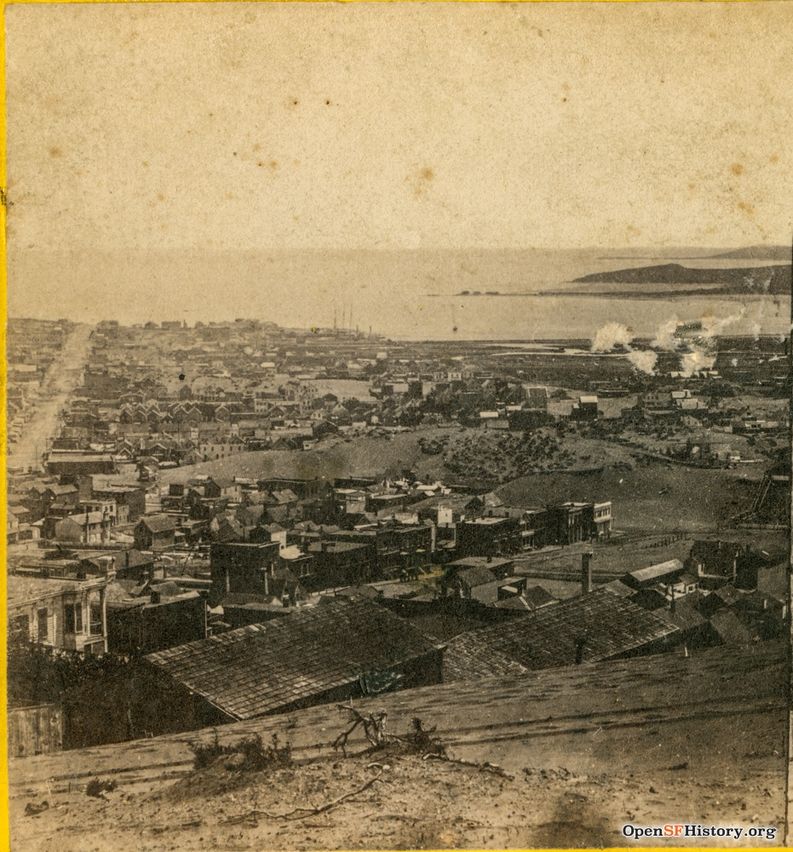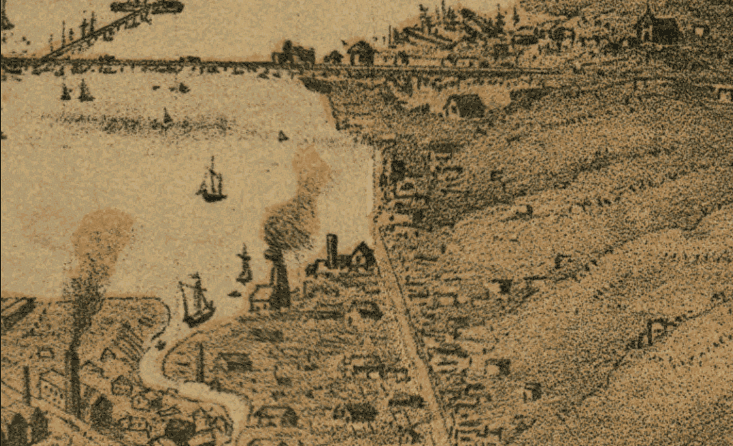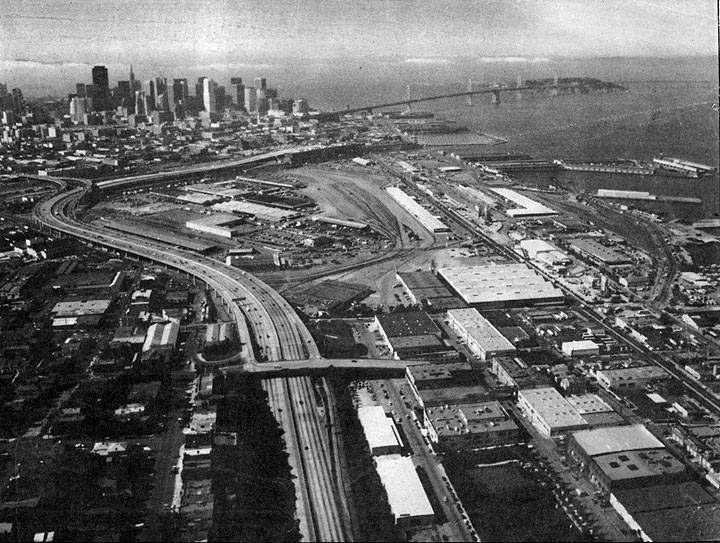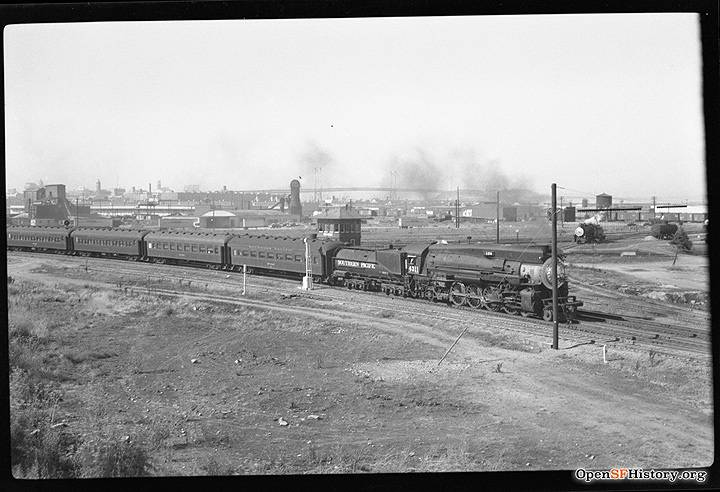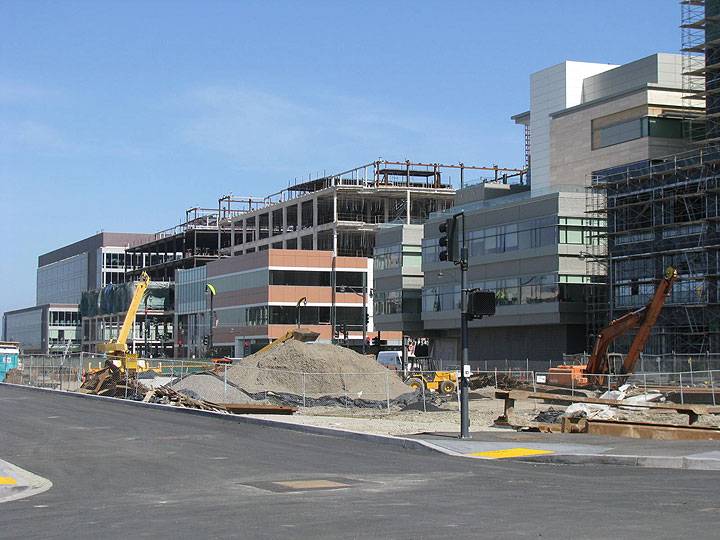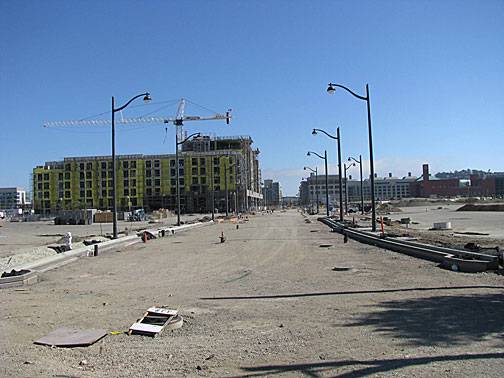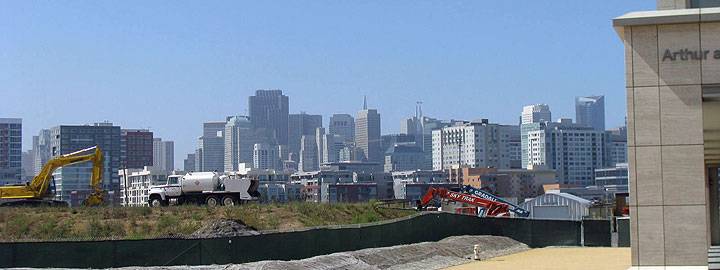MISSION BAY
Historical Essay
by Chris Carlsson
This 1860 photo taken from apx. Sacramento and Taylor on Nob Hill shows Mission Bay before it was filled. Street at left is 3rd Street, swamps begin to right of 4th Street. In the upper right distance is the original 3rd peak of Potrero Hill, known as Irish Hill. To it's left is Mission Rock.
Photo: courtesy OpenSFHistory.org wnp24.0149a
Mission Bay from slopes of Nob Hill, c. 1857.
Photo: courtesy OpenSFHistory.org wnp37.00897-L
This bird's eye view rendering of Mission Creek as it pours into Mission Bay was drawn in the 1870s. Long Bridge crosses the mouth of Mission Bay, roughly where 3rd Street runs today.
Image: Library of Congress
| Before urbanization, Mission Bay was a shallow bay teeming with marsh life. From 1860to 1910, steam shovels filled Mission Bay with rocks and dirt from sand hills in San Francisco. The resulting neighborhood was an industrial zone through the 20th century, containing mostly railroad land and warehouses. Today, Mission Bay continues to develop—the area is rapidly becoming a suburban hotspot, catalyzed in part by the expansion of the University of California, San Francisco campus. |
Go south on 4th Street until it intersects 3rd Street and you are in the middle of Mission Bay. In 1849, when the gold rush began and San Francisco was a small village on the northeast edge of the peninsula (near today's Montgomery Street), Mission Bay was actually a wide, shallow bay full of clams and oysters and teeming with marsh life.
From the 1850s to the late 1870s shipbuilding and repair at Steamboat Point (Townsend from 2nd to 4th Streets, at the time the southernmost point of land extending into Mission Bay) was the main industry around Mission Bay, while the waters continued to yield a healthy supply of oysters and clams (and also real estate profits!). Butchers got the land in the Mission Creek marshes near today's 9th and Brannan set aside as an industrial zone for their slaughter-houses (butchertown), and the blood and guts of their business was dumped directly into the creek on its way into the bay.
The steam shovel, the steam-paddy, was used intensively to shovel the 30- to 100-foot sand hills from various locations throughout the area from Market Street south, first along Townsend Street, and later 4th, 5th, and 6th Streets, depositing the material in Mission Bay. The long process of filling in the water lots in Mission Bay lasted from approximately 1860 to 1910. After the steam shovels had leveled the numerous sand hills, the Second Street cut in 1869 provided thousands of cubic yards of rock and dirt, followed soon after by early blasting of Irish Hill (today this is the land east of Illinois Street between 20th and 23rd Streets, home to abandoned Todd Shipyards and adjacent to a small residential district just east of Potrero Hill at 22nd & 3rd, affectionately known by locals as Dogpatch), which also contributed its rubble to the filling of Islais Cove. From the 1870s to the '90s garbage dumps along 7th & 8th Streets near Berry provided steady fill to the Bay. The earthquake debris from 1906 provided the last large quantity of fill, although many wet spots needed additional filling in the following years.
Mission Bay's business would eventually be subsumed by the nation's controlling capitalists of the time, the railroad barons.
Aerial view of Mission Bay (to right of freeway) in early 1980s when it was still railroad land with warehouses and industrial facilities.
Photo: Santa Fe Pacific Railroad
Mission Bay with Bay Bridge in background, view northerly in 1949.
Photo: courtesy OpenSFHistory.org wnp14.jpg
The China Basin building built in 1925 as part of the Del Monte Cannery empire, remains to this day a prominent landmark at the northern edge of Mission Bay, though it actually sits on what was once the Bay itself.
Today 7th & Berry is the site of a sewage treatment plant at the land end of the Mission Creek Channel. The channel is a delightful hidden community, home to a fleet of two dozen houseboats in the shadow of the useless (I-280) freeway spur built in the early 1970s to lead to a never-built second crossing bay bridge.
Mission Bay today is fast becoming a bit of suburbia implanted in San Francisco by the former real estate division of Southern Pacific Railroad, Catellus Corporation. To facilitate their exclusive development rights over their enormously valuable real estate, they donated 40+ acres to the University of California to build its new biomedical campus, which in turn greatly increased the value of the surrounding acreage. Here are some images of the newest part of San Francisco, built entirely on landfill, subject to liquefaction during earthquakes.
The growing campus under construction, May 2009.
Photo: Chris Carlsson
The future 4th Street extension into the heart of the UCSF campus.
Photo: Chris Carlsson
4th Street, still unopened, passing by the new UCSF as it rapidly emerges from the frenzy of building, May 2009.
Photo: Chris Carlsson
This 2009 view of San Francisco from the heart of the UCSF Mission Bay campus will be obscured within a year or two, as more and more buildings are constructed.
Photo: Chris Carlsson

